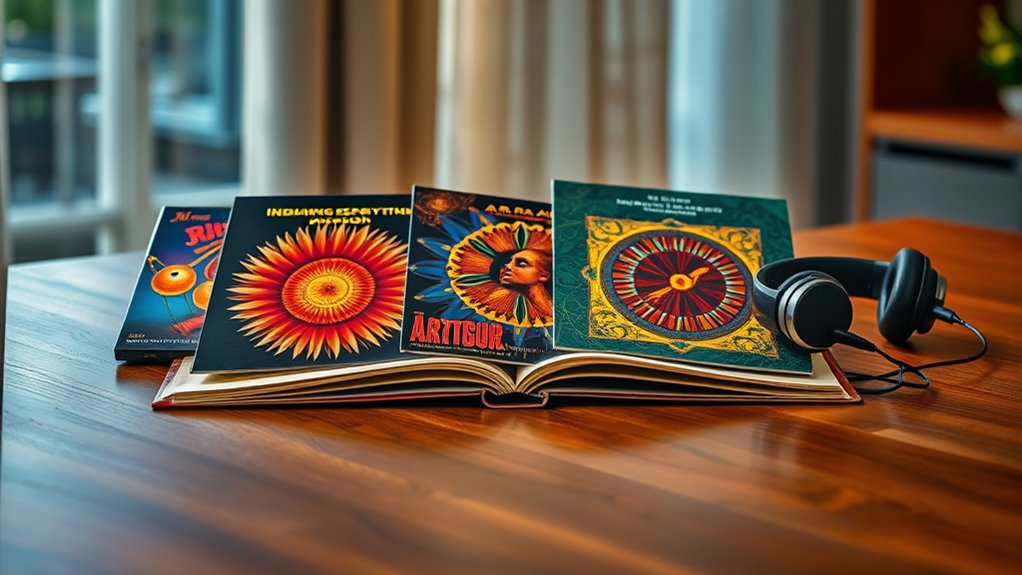To understand A.R. Rahman’s genius, start with these 10 essential songs that showcase his mastery of blending traditional sounds with modern innovation. From the vibrant colors of “Tere Rang” to the spiritual depths of “Kun Faya Kun,” each track highlights his unique fusion of folk, Sufi, classical, and electronic music. Exploring these will give you a powerful glimpse into his artistic versatility and cultural impact—keep exploring to discover even more of his groundbreaking work.
Key Takeaways
- Highlight Rahman’s skill in blending traditional Indian instruments with electronic music for a unique fusion sound.
- Showcase his mastery in combining spiritual themes with innovative production techniques.
- Emphasize his ability to evoke deep emotions through soulful melodies and cultural symbolism.
- Illustrate his genre-bending approach by merging devotional, folk, and modern musical styles.
- Present iconic songs like “Chaiyya Chaiyya” and “Kun Faya Kun” as examples of his artistic versatility.
Tere Rang: A Vibrant Celebration of Color and Emotion

Have you ever felt how a song can vividly paint a scene full of color and emotion? “Tere Rang” by A.R. Rahman does exactly that. As you listen, you’re drawn into a world of vibrant imagery and heartfelt feelings. The song’s lyrics, penned by Irshad Kamil, blend emotional depth with colorful descriptions of love and longing, referencing Krishna and Radha to evoke timeless devotion. The music seamlessly fuses traditional motifs with modern sounds, creating layered textures that resonate deeply. Haricharan Seshadri and Shreya Ghoshal deliver expressive vocals, while instruments like flute and bass guitar enrich the melody. This piece is a celebration of emotional and cultural richness, making you feel immersed in a beautiful, colorful world of love and sentiment. The song incorporates various musical sounds and rhythms to enhance its emotional impact and create a dynamic listening experience. Additionally, Rahman’s use of musical fusion techniques exemplifies his talent for blending diverse influences into a cohesive musical narrative. Exploring sound healing science principles reveals how Rahman’s innovative use of sound frequencies can evoke emotional responses and deepen the listener’s experience. Furthermore, Rahman’s mastery of layered textures contributes to the song’s emotional complexity, engaging listeners on multiple sensory levels. Recognizing the importance of cultural symbolism in his compositions helps deepen appreciation for his artistic depth. A deeper understanding of heat pump technology can also inspire us to appreciate how layered systems work harmoniously to improve efficiency and comfort in our environments.
Enna Solla Pogirai: A Fusion of Melodic Elegance and Modern Beats
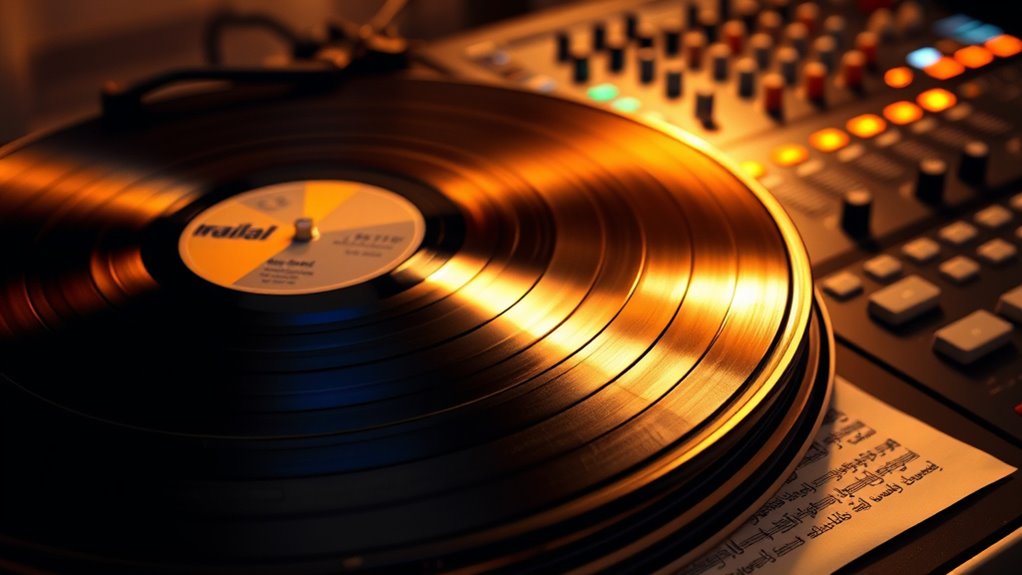
Enna Solla Pogirai exemplifies a masterful blend of melodic elegance and modern beats that continues to captivate audiences. Released in 2000 for the film Kandukondain Kandukondain, it showcases Shankar Mahadevan’s expressive vocals, enhanced by A.R. Rahman’s innovative composition. The song’s intricate harmonies and use of traditional Indian instruments fused with modern sounds create a rich, emotional experience. Its themes of longing and love resonate deeply, making it a cultural milestone in Tamil cinema. Recognized for its melodic sophistication, the song has influenced many subsequent works and remains popular across generations. Its enduring appeal, available on various platforms, underscores Rahman’s talent for merging traditional and contemporary styles, cementing Enna Solla Pogirai as a timeless example of musical ingenuity. The song also demonstrates Rahman’s mastery of fusion music, seamlessly blending diverse musical elements to craft a unique auditory experience. Additionally, its success reflects the growing influence of AI-driven insights in understanding audience preferences and enhancing musical creativity. Notably, Rahman’s innovative use of traditional Indian instruments alongside modern production techniques further exemplifies his pioneering approach to composition. This track exemplifies Rahman’s ability to innovate within musical genres, making it a quintessential piece to understand his artistic evolution. Moreover, Rahman’s approach to composition often incorporates personal growth principles, fostering continuous innovation and emotional connection through his music.
Yeh Haseen Vadiyan Yeh Khula Aasman: A Musical Ode to Nature’s Beauty
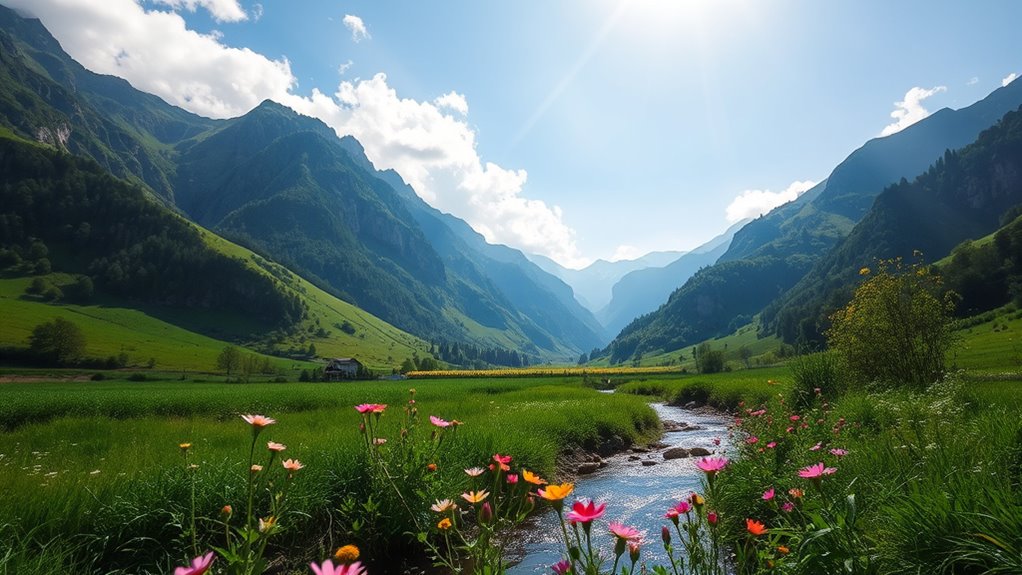
Yeh Haseen Vadiyan Yeh Khula Aasman stands out as a lyrical tribute to the breathtaking beauty of nature and love, beautifully composed by A.R. Rahman. The song’s soothing melody combines Indian classical instruments with modern orchestral sounds, creating a lush, evocative atmosphere. You feel the harmony in every layered vocal and instrumental detail, capturing the song’s gentle rhythm and moderate tempo. The lyrics describe valleys, open skies, and the beloved’s beauty, emphasizing love’s eternal and destined nature. This musical piece not only highlights Rahman’s innovative genius but also enhances the film’s narrative with emotional depth. Here’s a quick look at its essence:
| Musical Elements | Themes |
|---|---|
| Rich harmony | Nature’s beauty and love |
| Soothing melody | Destiny and eternity |
| Modern + classical instrumentation | Romantic and scenic imagery |
Additionally, Rahman’s mastery in blending diverse musical elements demonstrates his ability to craft timeless melodies that resonate across cultures.
Hosanna: Gospel-Inspired Energy and Spiritual Upliftment
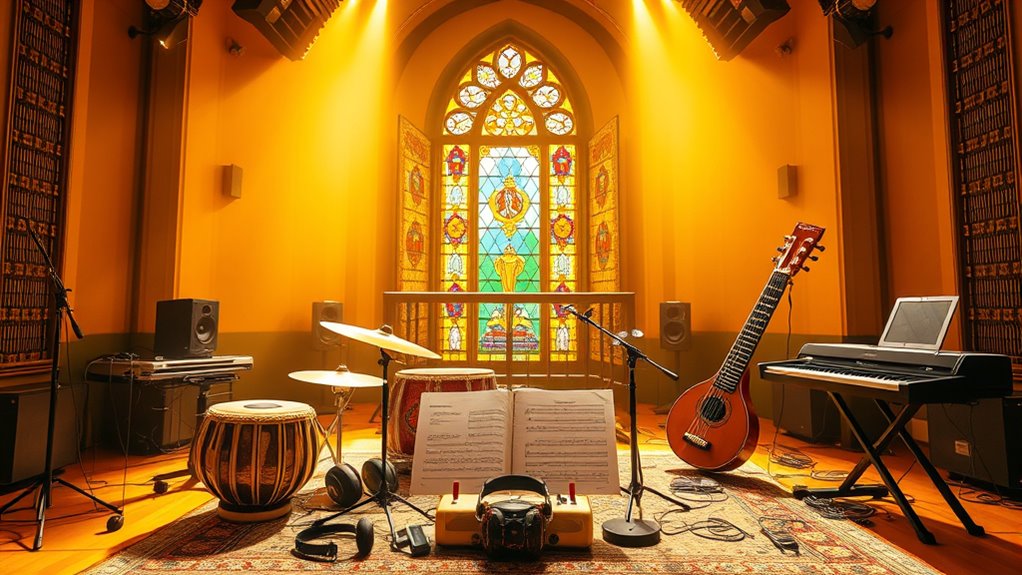
Ever wondered how A.R. Rahman infuses energy and spirituality into his music? “Hosanna” exemplifies this by blending gospel-inspired energy with deep emotional and spiritual themes. Composed for films like “Vinnaithaandi Varuvaayaa” and “Ye Maaya Chesave,” it uses the sacred term “Hosanna,” meaning “save now,” to evoke spiritual upliftment. The song features a mix of soulful vocals by Vijay Prakash and Leon D’Souza, along with rap interludes by Blaaze that add a modern edge. Its gradual build from slow to energetic pacing, combined with traditional and contemporary instrumentation, creates a powerful, uplifting atmosphere. Through its lyrics and music, “Hosanna” captures love, sacrifice, and spiritual joy, showcasing Rahman’s talent for fusing cultural themes into a transcendent musical experience. Recognizing Rahman’s ability to evoke spiritual upliftment through music highlights his mastery of blending cultural and emotional depth into his compositions. Additionally, Rahman’s expertise in musical fusion allows him to seamlessly blend diverse musical styles, enriching his compositions with emotional resonance. His innovative approach to musical instrumentation further elevates the spiritual and energetic qualities of his work, making his compositions uniquely impactful. Exploring yoga’s holistic healing principles can deepen our appreciation of how music like Rahman’s can promote emotional and spiritual well-being, illustrating the interconnectedness of art and inner harmony.
Kun Faya Kun: Sufi Mysticism and Transcendental Soundscapes

A.R. Rahman masterfully captures Sufi mysticism in “Kun Faya Kun,” a song rooted in divine will and spiritual surrender. You’ll notice how it draws from Islamic and Sufi traditions, with lyrics like “Be, and it is,” inspired by Quranic themes. The song’s fusion of traditional qawwali elements with contemporary orchestration creates a transcendental soundscape that resonates globally. Rahman uses layered vocals, live instruments, and electronic layers to evoke a meditative atmosphere. Its rhythmic fluidity and minimalist interludes intensify emotional depth, emphasizing themes of purification, hope, and divine light. This piece, featured in “Rockstar,” has touched many by blending spiritual lyrics with powerful, innovative music that bridges faith and artistry.
- Roots in Islamic and Sufi traditions
- Fusion of qawwali and modern sounds
- Use of layered vocals and rhythmic complexity
- Universal appeal fostering spiritual connection
Maahi Ve: Bollywood Romance With a Contemporary Twist

You’ll notice how “Maahi Ve” blends a modern romantic melody with contemporary sounds, making it feel fresh yet familiar. Rahman combines western-style arrangements with traditional Bollywood elements, creating a seamless fusion of styles. This approach highlights how the song redefines love songs for a new generation, balancing emotional depth with modern musical trends. The use of fusion techniques exemplifies Rahman’s ability to blend diverse musical influences into a cohesive and innovative composition. Additionally, the incorporation of natural sounds adds an organic layer that enriches the listening experience, reflecting his holistic approach to music creation. His mastery in music production ensures that every element harmoniously contributes to the song’s unique appeal.
Subheading 1: Modern Romantic Melody
“Maahi Ve” masterfully combines traditional Punjabi Sufi melodies with modern production techniques, creating a romantic track that feels both timeless and contemporary. The song’s slow introduction builds gradually into a steady pulse, maintaining a hypnotic rhythm. You’ll notice a droning effect that sustains a tonal foundation, tying the elements together seamlessly. The blend of folk instruments and electronic sounds crafts a fresh yet authentic soundscape. The consistent claps and beats evoke an ecstatic feeling, immersing you in the song’s emotional depth. Periodic flute interludes add melodic richness, enriching the texture. AR Rahman’s subtle vocal delivery enhances the song’s emotional depth, and this fusion of traditional and modern elements results in a modern romantic melody that captures the essence of love, spirituality, and cultural roots. Incorporating musical arrangement techniques and authentic instrumentation is essential in understanding his innovative approach to composition. Additionally, his mastery in balancing instrumental layers ensures that each element complements the others, creating a cohesive and captivating musical experience. Recognizing the importance of instrumentation and arrangement deepens appreciation for Rahman’s unique style. Exploring the use of electronic sounds reveals how he seamlessly integrates modern technology with traditional musical forms, further demonstrating his innovative genius.
Subheading 2: Fusion of Styles
“Maahi Ve” exemplifies how modern Bollywood music seamlessly blends traditional Punjabi Sufi sounds with contemporary musical techniques. You’ll notice the song incorporates Punjabi Sufi melodies with folk elements, featuring the Nooran Sisters’ authentic vocals. AR Rahman mixes techno and electronic Punjabi arrangements to create a unique soundscape, while flute melodies add a classical touch. Rhythmic claps and backing vocals evoke spiritual ecstasy, modernized for film. The song’s layered structure combines minimalistic beginnings with evolving textures, balancing tradition and innovation. This fusion supports the romantic story while respecting cultural roots.
| Traditional Elements | Modern Techniques |
|---|---|
| Punjabi Sufi vocals | Electronic arrangements |
| Folk rhythms | Techno beats |
| Flute motifs | Synth pads |
Kadhalikka Neramillai: Cross-Lingual Charm and Timeless Melody
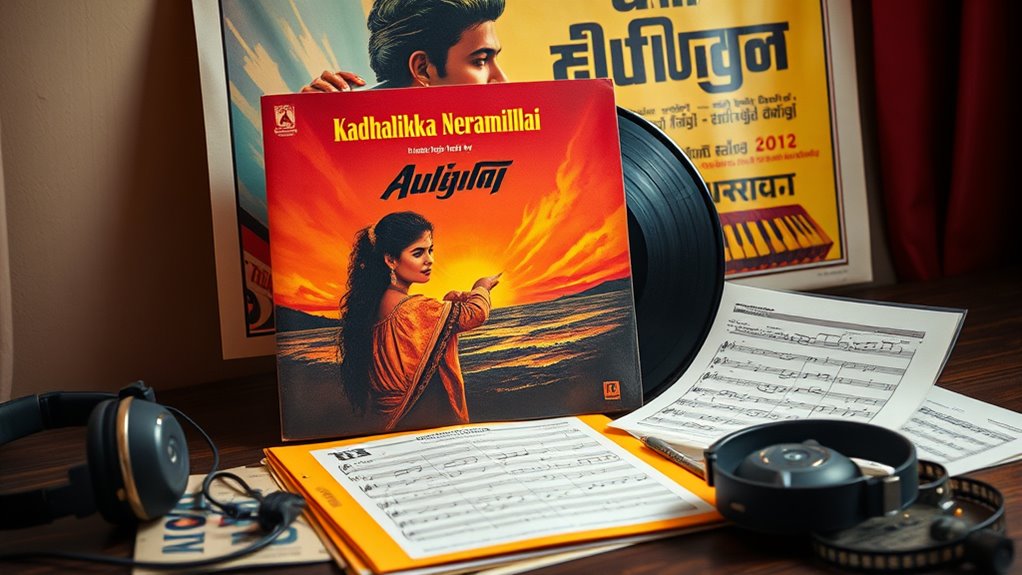
A.R. Rahman’s work on *Kadhalikka Neramillai* showcases his cross-lingual charm and timeless melody. His composition blends traditional and modern sounds, appealing to diverse audiences. You’ll notice Tamil roots in the music, but its universal appeal transcends language barriers thanks to soulful melodies and rhythms. The soundtrack features a variety of singers, including Rahman himself, Shreya Ghoshal, and Shruti Haasan, adding richness and depth. The songs explore themes of love and relationships, using classic orchestral elements and contemporary production to keep them fresh. The fusion of cultural influences creates a unique, resonant sound that stands the test of time. This combination of emotional resonance and musical versatility highlights Rahman’s genius in crafting music that’s both rooted and global.
Vande Mataram: Patriotism Expressed Through Powerful Composition

Building on Rahman’s ability to fuse diverse musical styles, his 1997 album *Vande Mataram* powerfully expresses patriotism through a compelling blend of traditional and modern sounds. You’ll notice the use of Indian classical instruments combined with electronic elements, creating a rich, emotive melody that stirs feelings of national pride. Rahman’s arrangement draws from the original patriotic poem by Bankim Chandra Chatterjee, updating it for contemporary audiences. The album’s fusion of genres bridges cultural divides, inspiring civic awareness and cultural exchange. Its international recognition and critical acclaim highlight its significance as a musical icon of Indian patriotism. Through *Vande Mataram*, Rahman not only revives traditional music but also encourages a modern, inclusive sense of national identity, leaving an enduring legacy.
Chaiyya Chaiyya: Rhythmic Fusion of Traditional and Urban Sounds
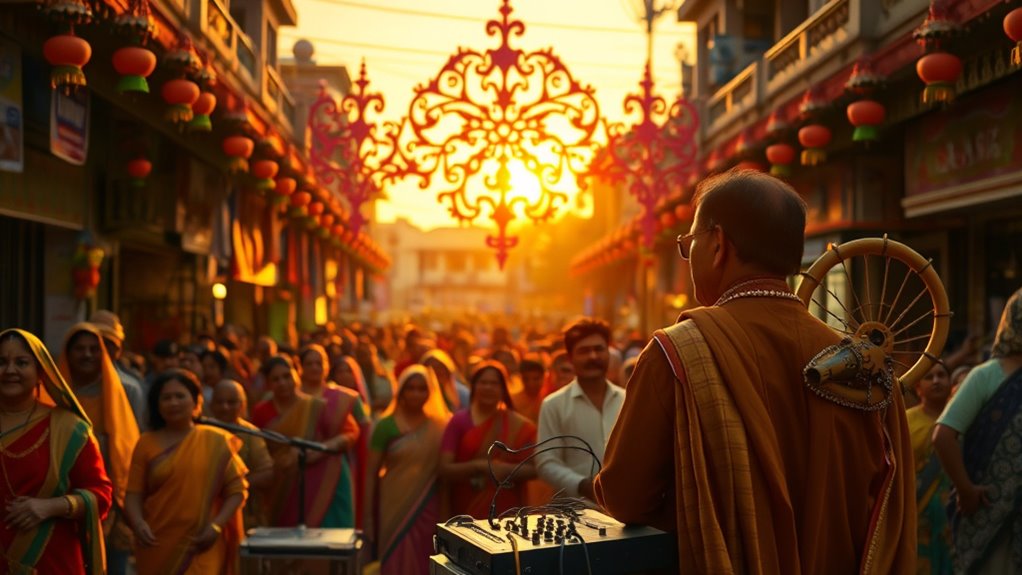
You can’t ignore how “Chaiyya Chaiyya” masterfully blends traditional rhythms with urban beats, creating a fresh fusion that energizes listeners. The song’s dynamic vocal energy drives this mix, making it both powerful and accessible. This seamless fusion highlights Rahman’s skill in combining diverse musical elements into a mesmerizing experience.
Fusion of Rhythms
How does “Chaiyya Chaiyya” masterfully blend traditional and urban rhythms to create a vibrant, infectious sound? Rahman combines energetic percussion inspired by traditional instruments like the tabla with modern electronic beats, producing a dynamic fusion. The song draws from Sufi music and Urdu poetry, adding spiritual depth. Vocals by Sukhwinder Singh and Sapna Awasthi weave melodious harmonies that bridge rural and urban styles. The rhythmic patterns are crafted to evoke movement and energy, exemplifying Rahman’s skill in balancing tempo and melody. This fusion not only creates a compelling sound but also reflects cultural diversity, making the song resonate worldwide.
- Incorporation of traditional percussion and electronic beats
- Sufi influences adding spiritual layers
- Harmonious blend of vocal styles
- Rhythmic patterns evoking movement
Traditional Meets Urban
“Chaiyya Chaiyya” exemplifies the seamless fusion of traditional Sufi music with contemporary urban sounds, creating a vibrant crossroad where cultural roots meet modernity. You hear traditional instruments like the dholak and harmonium layered with electronic beats, producing a rhythmic complexity that appeals to diverse audiences. The lyrics, drawn from 18th-century poet Bulleh Shah, evoke spiritual love and devotion, while visuals in the film blend urban cityscapes with rural motifs. This blend highlights how tradition can energize modern storytelling, making the song both culturally rich and globally accessible.
| Traditional Elements | Urban Influences |
|---|---|
| Sufi rhythms, folk instruments | Electronic beats, choreography |
| Devotional lyrics, metaphors | Cinematic visuals, cityscapes |
| Spiritual themes | Modern production techniques |
| Cultural heritage | Mainstream appeal |
Dynamic Vocal Energy
What makes “Chaiyya Chaiyya” stand out is its electrifying vocal energy that seamlessly blends traditional and urban sounds. Sukhwinder Singh and Sapna Awasthi deliver raw, powerful vocals that create a sense of urgency and celebration. Their call-and-response interplay adds a dynamic, conversational feel, keeping you engaged. The song’s brisk tempo and syncopated rhythms fuse Indian percussion with modern beats, encouraging movement. High stamina is essential to sustain the energetic delivery, especially during the song’s rapid phrases. Vocal layers build excitement and complexity, heightening the emotional impact. The energetic vocals mirror the lively choreography, intensifying the cinematic storytelling. Overall, this track exemplifies how passionate vocal performance drives the fusion of tradition and contemporary sound.
Dreamum Wakeupum: An Experimental Track Showcasing Rahman’s Versatility

Dreamum Wakeupum exemplifies A.R. Rahman’s experimental spirit and musical versatility. Released in 2012 as part of the film “Aiyyaa,” it pushes boundaries with its unconventional sound. The track blends electronic beats with traditional elements, creating a playful, rhythmic mix that’s both catchy and complex. Its bold lyrics use playful wordplay and repetitive “-um” endings, exploring themes of desire, lust, and inner turmoil. The lively shifts in vocal style demonstrate Rahman’s ability to fuse diverse genres seamlessly. Despite its niche appeal, the song made a significant cultural impact, showcasing his willingness to experiment beyond mainstream Bollywood norms. It exemplifies Rahman’s talent for crafting innovative, genre-blending music that challenges expectations and broadens the scope of Indian film scores.
Frequently Asked Questions
How Did A.R. Rahman Innovate Indian Film Music?
You see, A.R. Rahman revolutionized Indian film music by adopting digital audio workstations early on, blending traditional Indian sounds with Western styles, and experimenting with electronic beats. He used immersive audio techniques like 7.1 surround sound, creating layered, expansive soundtracks. His innovative approach, combining cultural authenticity with modern technology, gained international fame, breaking barriers and transforming how Indian film music is perceived worldwide.
What Are Rahman’s Most Streamed Songs Worldwide?
Wondering which of Rahman’s songs win worldwide streams? You’ll find that “Agar Tum Saath Ho” tops the list with over 290 million streams, showcasing its soulful appeal. Other chart-toppers include “Jai Ho” and “Enna Sona,” each mesmerizing millions globally. These tracks highlight Rahman’s remarkable range, blending traditional tunes with modern melodies, making his music a must-listen for fans across the world.
Which Genres Does Rahman Blend in His Compositions?
You’ll find that Rahman blends several genres in his compositions. He combines Indian classical music with Western classical and rock influences, creating a fusion that appeals worldwide. He also incorporates electronic sounds to modernize traditional melodies and adds world music elements for cultural depth. This blending results in emotionally rich, innovative music that spans genres, making his work distinctive and globally recognized while fostering cross-cultural understanding.
How Has Rahman Influenced Global Music and Collaborations?
You see how Rahman’s influence on global music is immense. He collaborates worldwide, blending Indian sounds with Western styles like Broadway and pop, which expands his reach. His innovative use of technology and cross-cultural compositions inspire artists globally. By scoring international films and partnering with renowned artists, he breaks cultural barriers, making Indian music accessible worldwide and transforming the global music scene with his unique fusion.
What Lyrical Themes Are Common Across Rahman’s Popular Tracks?
Some might think Rahman’s lyrics are purely melodic, but they often explore profound themes. You’ll notice recurring ideas like spiritual journeys, urging you to look inward for truth and love. His songs also explore into love and heartbreak with emotional resilience, emphasizing growth and hope. Additionally, themes of social struggle and redemption appear, using nature and feminine symbolism to add poetic depth. These layered themes make his music both inspiring and meaningful.
Conclusion
Now that you’ve explored these 10 songs, you see how A.R. Rahman’s genius spans genres and emotions. Did you know he’s won 2 Academy Awards and 4 Grammys? His ability to blend traditional sounds with modern music keeps audiences captivated worldwide. Keep listening, and you’ll discover how each track reveals a new layer of his musical mastery. Rahman isn’t just a composer—he’s a global icon shaping the future of music.
